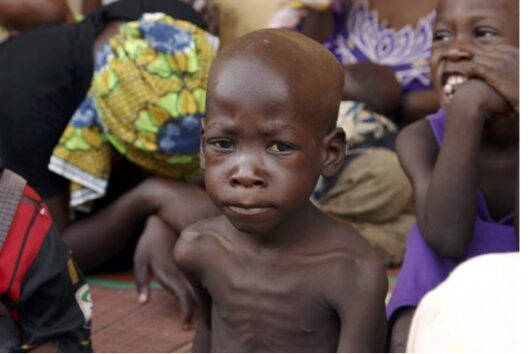The five-year-old child in this photo presents to your health center in the Democratic Republic of the Congo. History is obtained from family members, who explain that eight months ago their farm was attacked by bandits. The family has been on the move by foot since then, seeking asylum and being frequently harassed. No one in the family, including this child named Aamir, has eaten regularly in months. What’s more, in recent days Aamir has developed fever, diarrhea, and lethargy.
Upon initial physical examination you note that Aamir is poorly responsive to stimulation. His temperature is 38 degrees C, respirations are 30 per minute, pulse is 90 bpm, and blood pressure is unobtainable. He has a mid-upper arm circumference of 107mm, hair discoloration that is red in color, and loss of adipose tissue with no peripheral edema. He has no appetite and refuses to drink. Aamir’s mid-arm circumference and skin fold thickness measurements are well below the norm. You have no laboratory or radiology support for further investigation.
The first priority in the management of this child with severe acute malnutrition (SAM) is which ONE of the following:
A Emergency treatment of coexisting medical illnesses.
B Assignment to a community-based renutrition program.
C Administration of vitamin A, zinc, and iron supplements.
D Refeeding 100 kcal/kg/day with standard WHO ready-to-eat food (RUTF).
E Rehydration with 10ml/kg/hr of half-strength WHO Oral Rehydration Solution by mouth or nasogastric feeding.
Explanation: The management of SAM can be separated into two stages. The first stage is stabilization: immediately correct hydration and acid-base alterations. The second stage is rehabilitation. Rehabilitation can begin as soon as medical problems are reasonably stable and rehydration is complete. It may be necessary to begin initial refeeding slowly in persons who have SAM because of damage to the intestinal mucosa. During rehabilitation, micronutrient supplements and attention to any coexisting medical illnesses may also be indicated. The correct answer is E.

